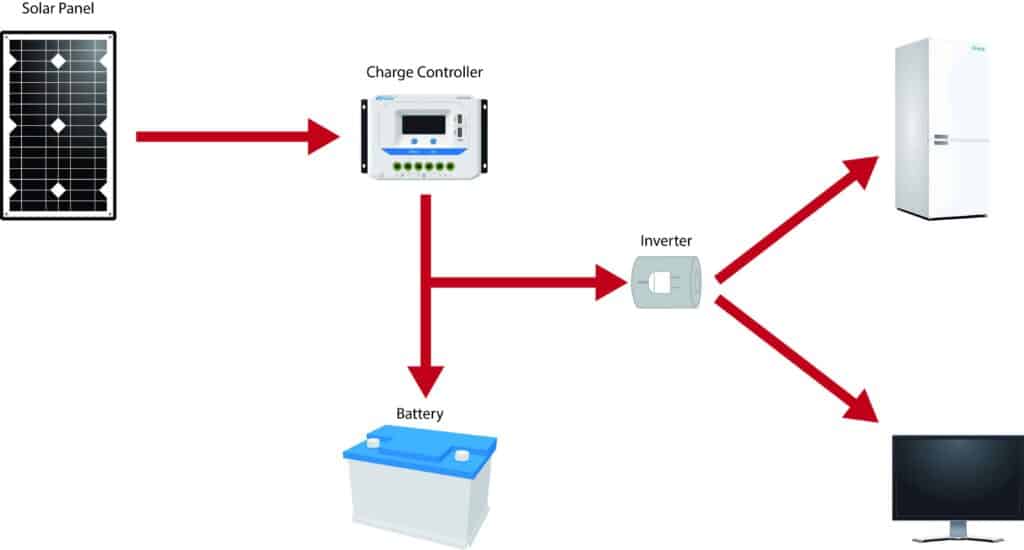Table of Contents
Solar Charge Controller 101: A Basic Guide for Beginners
A solar charge controller is an essential part of a solar system that uses batteries.
This basic guide explains what it does and why it’s important to a solar energy system.
What does a charge controller do?
A solar charge controller manages the power going in and out of the batteries in a solar power system. It does this by regulating voltage and current.
It stops your batteries getting overcharged by controlling the flow of energy from your solar panels.
It also stops the reverse flow of power, which can drain and damage the battery bank, from your batteries to your solar panels.
We use a charge controller where there is a battery. This might be in:
- In an off-grid system or
- A grid-tied battery backup system.
The most basic controller will tell you how much power your solar array has generated, how much you have used, and how much is stored in your batteries.
Newer models allow you to remotely monitor this from your phone via the internet.

What else does it do?
Aside from preventing overcharging and draining of a battery, charge controllers perform other functions as a battery management system.
One of these functions is to balance the batteries.
As batteries age, the charge of each battery in a battery bank differs. The rate at which each battery charges and discharges varies.
Over time, this degrades the whole battery bank. A charge controller prevents this from happening.
Charge controllers also:
- Match the solar panels’ voltage to the battery bank’s voltage.
- Monitor temperature to prevent the batteries from overheating.
- Disconnect loads from the battery and preventing over-discharge.
When do you need a charge controller?
If you want to have batteries as part of your home solar system, you’re going to need a charge controller. The chief function of a controller is to protect your batteries.
Since batteries are the most expensive part of a solar power system, you want to protect your investment.
Types of charge controllers
Unlike batteries or inverters that have several types, controllers are much simpler in that you have two options to choose from. You either go MPPT or PWM.
Maximum Power Point Tracking (MPPT)
MPPTs squeeze the most energy from a solar array.
MPPT controllers take the maximum power from a solar array, regardless of the battery’s required voltage, and deliver that to the battery bank.
They can do this because, unlike PWM controllers, they can reduce or step down the solar arrays’ voltage to the battery’s voltage.
Pros of MPPT charge controllers
MPPT controllers have some advantages over PWM controllers. These are:
- They’re more efficient.
- They allow you to connect a higher voltage solar array to a low voltage battery (for example, a 150V solar panel to a 12V battery).
- MPPT allows you to use a higher voltage array. This allows you to install your solar panels further away from your batteries without having to compensate by spending a lot on wiring.
Cons
- An MPPT controller is more expensive than PWM.
Pulse Width Modulation (PWM)
With Pulse Width Modulation controllers, the voltage from the solar panel has to match the voltage from the battery.
If a solar array has a voltage of 17V and the battery bank has 14V, the solar controller can only use 14V reducing the amount of power.
With Pulse Width Modulation controllers, as the batteries approach their full charge, current to the batteries is regulated by “pulsing” the charge (switching the power on and off).
Pulsing allows the battery to accept the charge and get fully charged.
Pros of PWM charge controllers
PWM has some advantages over MPPT: These are:
- Ideal for smaller solar systems as they come in sizes to match small solar applications
- They’re cheaper.
- They work well as load controllers.
Cons
- Not as efficient as MPPT in delivering power from array to batteries.
- At present you can only be them with lead-acid batteries.
Solar charge controller FAQs
These are answers to the most asked questions about charge controllers.
What size charge controller do I need?
It has to be sized big enough to handle the power and current from your solar panels. Charge controllers come in 12, 24, and 48 volts. Amperage is between 1-60 amps and voltage 6-60 volts.
Is a charge controller the same as an inverter?
No. An inverter converts DC power from a solar panel into AC power for the home. Charge controllers manage the charging and discharging of batteries. These are two different functions.
Can you connect solar panels directly to a battery?
Can you just skip using a charge controller? Yes, however, you risk overcharging your batteries and gradually damaging them.
The only exception is if the power rating of your solar panel is less than 2% of the storage capacity of your batteries.
Conclusion
A solar charge controller is a handy piece of equipment that is almost always necessary as part of a battery bank in a solar system.
If you’re going to have batteries, you’re going to need it.
Think you’re up to speed on solar? Take our 5 minute Solar 101 Quiz and test your knowledge.